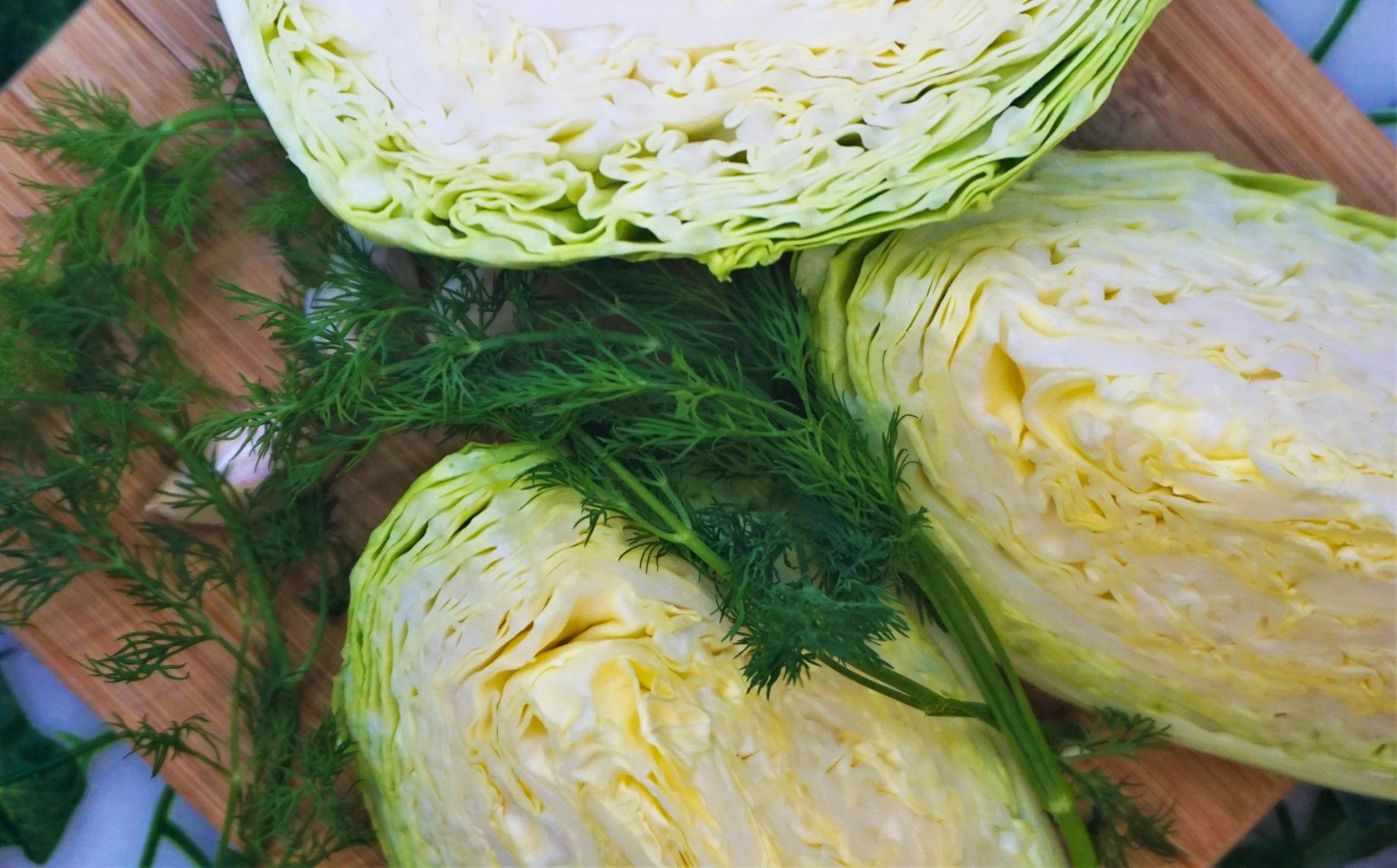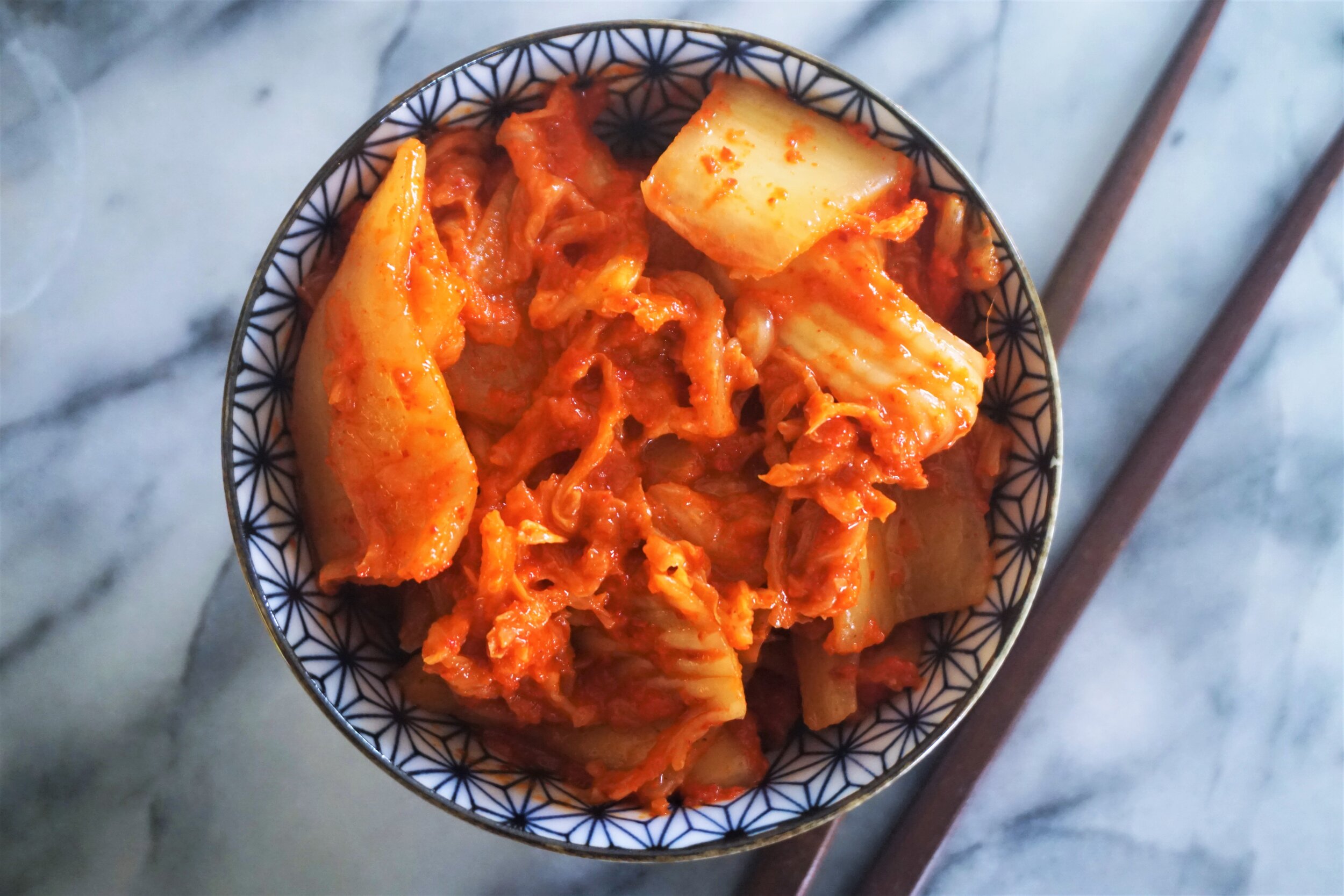Probiotic Garlic & Dill Sauerkraut

For thousands of years, humans have utilized the fermentation process to preserve, increase digestibility, and diversify nutrient content of foods. Because this is a post about sauerkraut, I am going to be discussing fermentation in the context of cabbage, but let it be known that many other foods have fermentation potential, including beets, potatoes, soybeans, and milk products to name a few.
The naturally occurring microbes on cabbage are given an ideal environment to thrive, and the pathogenic microbes (those than can cause illness) are sequestered in the fermentation process. Although we are curating an environment ideal for the good, probiotic microbes our gut needs for optimal health, there are certain health risks associated with fermenting. Therefore, proper food safety standards need to be upheld. Wash your hands, rinse, and remove the outer leaves of the cabbage, make sure your workspace is clean as are the kitchen tools you are using. Botulism, salmonella, and listeria are all foodborne pathogens known to inoculate fermented foods if they are not prepared and stored properly.




Fermented foods can positively affect the gut microbiota by replenishing the good and bad microbes that die off, particularly the bad if your diet has lots of refined grains and sugars (i.e. those found in processed foods). The gut and the brain are connected by thousands of nerves and are in constant communication. If your gut is in dysbiosis, it can affect your mental health (read about gut dysbiosis here). Researchers in Australia and Finland have found that treating people who suffer from Anorexia Nervosa with fermented foods can decrease the inflammation in their gut, which has shown potential to decrease psychological symptoms. This knowledge is cutting-edge, and just the beginning of a wave of studies linking the gut microbiota to mental health (read more about it here).
Healing your gut is a great way to take control of your mental health. It may not be the only answer, but consuming a variety of fruits and vegetables, whole grains, legumes, healthy fats, lean meats, and fermented foods can only be a step in the right direction. Taking control of your diet is taking control of your life! If you are interested in doing some of your own research, this is a great, up-to-date article that covers the definition of fermented foods and probiotics, the proposed nutritional benefits, the risks, and even regulation.
*Fills one quart jar
Ingredients:
1 small/medium green cabbage (900g)
Sea salt (2.5% 22.5 g salt)
4 g fresh dill (1/4 cup loosely packed)
2 garlic cloves
1/2 tsp caraway seeds
1/2 tsp mustard seed
Directions:
Place the bowl you will be putting your sliced cabbage in on a digital kitchen scale and zero it.
Peel off the very outer layers of the cabbage and rinse the rest. Section the cabbage into quarters and cut out the stalk. Finely slice the rest of the cabbage, adding the sliced cabbage to the bowl on the kitchen scale.
Take the final weight of the sliced cabbage and multiply it by 0.025. We are trying to find what 2.5% is of the weight. This is how mcuh salt you must add. For example, my sliced cabbage weighed an even 900g, and 0.025 x 900 = 22.5 therefore I used 22.5g salt.
Add the salt to the bowl and massage it with your hands for about 5 minutes, until it has noticeably wilted and feels quite wet. Cover and let sit on the counter for 45 minutes to 1 hour.
While you let the cabbage rest, slice 2 garlic cloves thinly and roughly chop the fresh dill. Set aside.
Massage the cabbage again for about a minute. It should feel limp and wet, and there should be water pooling in the bottom of the bowl. Add the sliced garlic, dill, caraway, and mustard seeds. Stir with a spoon or your hands until it looks evenly combined.
Place a clean quart-sized jar (or 2 pint-sized jars) on a plate. Start spooning the cabbage mixture into the jar (or use your hands). When the jar is about 1/4 way full, pack it down using a jar packing tool, a wooden spoon, or a spatula. Keep doing this as you fill the jar.
Once you have put all the cabbage into the jar and packed it down, if there is room you can pour in the rest of the liquid left in the bowl. Once you do this, sprinkle a pinch of salt on the very top of the liquid. This will ensure there is a protective layer of salinity to prevent bad bacterial growth. Close the jar with a lid and place in a dark spot that isn’t too cold.
Open the lid and pack the cabbage down every day, even twice a day if you can. You HAVE to remember to do this, otherwise your jar might explode! Cabbage is VERY active in ferments and goes incredibly quickly.
Ferment for 2 - 10 days. The longer it ferments the softer it will be. I prefer my sauerkraut to be on the crunchier side, so I let mine go for 4-5 days.






